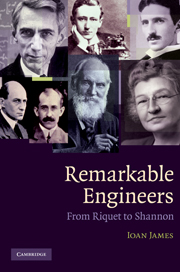Book contents
- Frontmatter
- Contents
- Preface
- Prologue
- 1 From Riquet to Watt
- 2 From Jessop to Marc Isambard Brunel
- 3 From Trevithick to Sadi Carnot
- 4 From Henry to Bazalgette
- 5 From Eads to Bell
- 6 From Braun to Hertz
- 7 From Diesel to Marconi
- 8 From Pal'chinskii to Zworykin
- 9 From Gabor to Shannon
- Epilogue
- Bibliography
- Credits
- Image credits
1 - From Riquet to Watt
Published online by Cambridge University Press: 17 December 2010
- Frontmatter
- Contents
- Preface
- Prologue
- 1 From Riquet to Watt
- 2 From Jessop to Marc Isambard Brunel
- 3 From Trevithick to Sadi Carnot
- 4 From Henry to Bazalgette
- 5 From Eads to Bell
- 6 From Braun to Hertz
- 7 From Diesel to Marconi
- 8 From Pal'chinskii to Zworykin
- 9 From Gabor to Shannon
- Epilogue
- Bibliography
- Credits
- Image credits
Summary
PIERRE-PAUL RIQUET (1604–1680)
The idea of a canal between the Atlantic and the Mediterranean, cutting out the long and dangerous haul around the coasts of the Iberian Peninsula, had been conceived by Leonardo da Vinci. Although much discussed, it remained no more than an idea until the middle of the seventeenth century, when the Grand Canal de Languedoc came into being. Voltaire, writing of the building achievements of the reign of Louis XIV, described it as ‘le monument le plus glorieux’ and Skempton describes it in the History of Technology (Singer et al., 1954–84) as, ‘the greatest feat of civil engineering in Europe between Roman times and the nineteenth century.’ Nowadays the canal, known as the Canal du Midi, is mainly used by pleasure boats but there is still some commercial traffic.
The man who was responsible for the construction of the canal was born at the town of Béziers, not far from Montpellier, on 29 June 1604 to Guillaume Riquet, a wealthy lawyer, and his wife. The Riquet family are said to be of Italian origin, but centuries earlier they had settled in the Languedoc region of France. Riquet was educated at the Jesuit college in Béziers, where he excelled in science and mathematics, but he received no formal training in engineering. At 19, he married Catherine de Milhau, the daughter of a wealthy bourgeois family of Béziers, whose dowry was such that he was able to purchase the old chateau and estate of Bonrepos, near the little village of Verfeil 12 miles to the east of Toulouse, on the slopes of the valley of the river Girou.
Information
- Type
- Chapter
- Information
- Remarkable EngineersFrom Riquet to Shannon, pp. 1 - 15Publisher: Cambridge University PressPrint publication year: 2010
